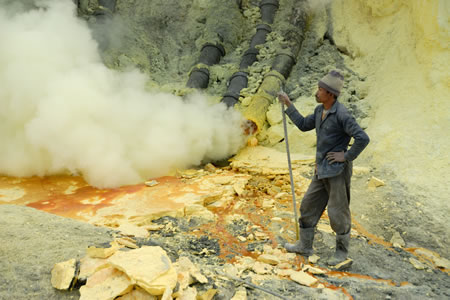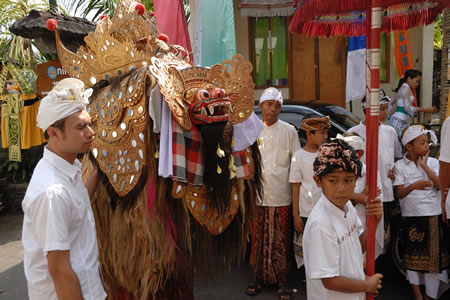English | Dutch |
|
| Good food, volcanos and Galungan | |
Yogyakarta (Indonesia) to Ubud (Indonesia), Jul-31-08 / Aug-20-08 |
|
Here we are sitting in our sarongs. Today it is Galungan, an important religious day for the Hindu community on Bali. The female owner of our hotel has emphasized several times that we should wear sarongs today. She compares the importance of this day with the importance of Christmas for the Christians. This means for her that everybody should be dressed in the traditional cloths. Believers as well as tourists should be dressed in a sarong to celebrate Galungan in a proper way. Edwin feels a bit uncomfortable in his skirt. The sarongs are definitely not made for his size. Although it is certainly not a miniskirt, it is obvious that he isn’t used to this kind of dress. When we walk through the streets of the touristy town Ubud, we see that most tourists don’t have such a caring hotel owner that gives clothing advises. On the streets it doesn’t seem a problem to walk in “normal” clothes, but in temples everybody should always be dressed traditionally especially on such an important day. This is a fact that can’t be overlooked by anybody. On every temple there is a clear sign in English to explain the dress code to every visitor. Every visitor should be dressed in a sarong and otherwise you shouldn’t enter the temple. Still, most tourists’ legs are covered by shorts. Fortunately, most Balinese don’t seem offended. The entire island is packed with tourists. We have seen many Balinese men and women laughing behind the back of skimpy dressed westerners, but everybody knows that the island is largely dependent on the money that those tourists spend. Nobody will say something to a tourist who doesn’t comply with the local habits. It is tolerated, but it isn’t accepted We have settled down for several days at Bali in anticipation of our flight to Manado on the island of Sulawesi. In the last weeks we have travelled from Java to Malaysia and back again to visit some sights at Java and travel onwards to Bali. In Malaysia we have arranged our second 60 day visa for Indonesia. Because we could do this easily in Georgetown, we had some spare time to take a closer look at the city of Georgetown. (See also the photo impression: Georgetown: a fine example of colonial Malaysia) We strolled through the narrow streets of Chinatown and Little India and we enjoyed the marvellous Malaysian food. The food in Malaysia is always a pleasure. No matter where you go, whether you spend a fortune or just a little bit, the food in Malaysia is always tasty. We have also spent some time preparing our visit to Sulawesi. On Sulawesi we want to follow a diving course and therefore we had to buy some contact lenses to replace our glasses. Moreover, we have spent several hours in Georgetown in our bed. Ivonne has had a fierce throat infection. After a week of pain and hoping that taking some rest would do the trick, she almost couldn’t eat anymore. Taking rest was, unfortunately, not enough. Some antibiotics were needed. |
|
 |
|
A sulphur worker is breaking the sulpher plates |
|
| After our visit to Georgetown, we flew back to Jakarta. At the immigration office we had to give a lot of explanations about the reasons that we are bringing another 60 day visit to Indonesia. Apparently, they have difficulties understanding why travellers want to spend such a long time in their country. Indonesia, however, is so big and travelling around takes so much time that we will probably need several new visas before we have seen the islands that we like to see. From Jakarta, we travelled by train to Surabaya. For most travellers, this is just a city to get from one train into the other to get to one of the main attractions of Java. We also stayed only for two nights in Surabaya, because there aren’t many places of interest in this city. However, the city is pleasantly friendly. Lack of tourists is probably the reason that the people are happy to greet you in their restaurant and the people are sincerely helpful. From Surabaya, we travelled to the Bromo volcano. During this journey, we were kicked out of a bus for the first time of our lives. (Read the whole story in: The two of you … get out of my bus!) This laborious start of our visit to the Bromo, didn’t have a negative impact on the visit of the Bromo and his surroundings. Even the fact that our visit coincided with the tourist high season didn’t have a negative impact, because we could easily skirt around the mass of people. (See also the article: Sunrise at the Bromo) The views on the volcanic landscape surrounding the Bromo were simply marvellous. We certainly understand why this is the main natural tourist attraction of Java.
The Ijen Plateau in the eastern part of Java was the next destination on our route. Here, we made the walk to Kawah Ijen. Kawah Ijen is a turquoise-blue large crater lake where sulphur is extracted. During the walk, we could see clearly how hard the work of the sulphur workers is. Men on flip-flops walk up and down the steep gravely paths to the edge of the lake to where sulphur fumes from the volcano are led by metal pipes. We don’t know exactly how it works, but it seems that the fumes solidify into hard sulphur plates. These plates are chopped into blocks and these sulphur blocks are carried in baskets by the men. Every time, the men can take approximately 50 kg from the lake to the place where they get 600 Rp (EUR 0,42) per kg. We found it sad to see that those people are doing such unhealthy work for such a small amount of money. On one day, a man can walk two times to the lake and back again. This means that they inhale the toxic fumes for a maximum revenue of EUR 4,20 per day. | |
 |
|
Balinese people celebrate the Galungan festival in Ubud |
|
From the Ijen Plateau we went to Bali, where we still are now. We have a nice hotel in the centre of the touristy place Ubud. Ubud is known to be an artistic village and due to the number of art galleries you could say that this reputation is correct. While some of the paintings on display are beautiful, many galleries show paintings that our little niece and nephews could have made but of course this is just a matter of taste. Bali is a Hindu island, but they experience their religion in a different way than the de Indians do. In Bali, the Hindu religion is more mixed with ancient animistic religions. The people believe in good and bad spirits. The good spirits inhabit among others the beautiful hills of Bali while the bad spirits reside in the deep parts of the sea. We try to forget the latter, before we start our diving course. The most conspicuous feature of the Balinese religion is the amount of offerings that people make to pleasure the good spirits and to restrain the bad spirits. We see the offerings being made on the streets but also in our hotel. We live in a small family hotel with only 4 bungalows and everyday a girl stops by to put offerings on the stairs to our bungalow and on our veranda. We call her the temple girl. The temple girl spends daily at least one hour to prepare and make the offerings. She makes little squares from banana leaves to put some rice on and she makes little baskets from banana leaves which she fills with flowers and incense. Not only the temple girl makes these kinds of offerings, but every sidewalk is covered with them. It looks very colourful, but the first days we really had to mind our step to prevent us from stepping on one. During the last days, we have seen men working for hours in a row to decorate metres high poles of bamboo with flowers and other materials. Al this work is done for the religious holiday of today. The streets are decorated with the beautiful bamboo poles, everyone is dressed the best they can and the temples are chockfull with people. Everywhere there are offerings on the street and people with big drums and gongs fill the streets with music. On the rhythm of the music are men dancing in lion costumes while the women are looking with admiration. For us, this is a nice way to end our visit to Java and Bali. Tomorrow, we will fly to Sulawesi to see what that island has to offer.
|
|
| <Previous weblog> | |